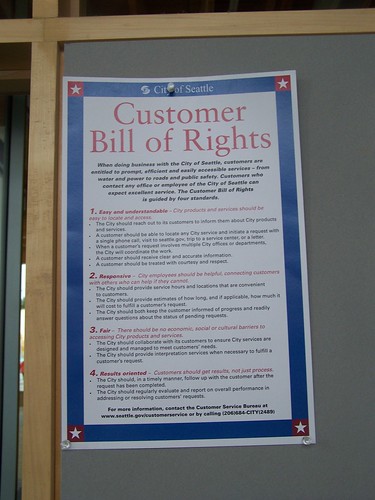Level of Service and Level of Quality aren't just concepts from transportation planning
Yesterday's Post has a story about the debacle of providing benefits and services to people receiving various health and welfare benefits, "D.C.'s stressed aid centers are a stressor for poor residents." From the article:
City officials say a combination of recent budget cuts and the continued economic slowdown have led to extended waiting times. Last year, the administration of Mayor Adrian M. Fenty (D) closed two of the seven IMA service centers to save a little under $1 million. Although the administration pledged that the remaining centers would be wellstaffed, District officials say those promises have been stymied by the recession, which has limited the city's ability to hire workers.
At the same time, the Department of Human Services is facing a growing demand for services as the city's unemployment rate has climbed to 10 percent; in Ward 8, the figure is 28 percent. According to the U.S. Department of Agriculture, about 103,000 District residents participate in the food stamp program, a 22 percent increase since 2007.
City officials say they are working to hire more people, install self-service kiosks and redesign the Anacostia center.
Apparently DC Government closed at least 2 offices, and there aren't enough people at the other offices to deal with the demand.
Plus people have to travel a long time to get to the offices, because they are located far from where they live.
Plus people are required to come back the next day after waiting all day and not receiving service.
It's appalling. And for all the talk about customer service on the part of local government (which, by the way, usually comes at the diminution of the role of the citizen as a citizen who empowers the process of governance to begin with) clearly there is a major disconnect.
With simple GIS analysis (and the DC Government is replete with GIS resources) you can determine where your "customers" are located, and the level of transit service from those areas, and how long it takes to travel.
Location decisions should be based on the most simple way to serve customers, not on the convenience of government, and hopefully not as part of an unstated policy to deliberately dis-serve people to make government hard to get to, to reduce the likelihood of having to provide service.
And people who are not served and have to return should be receiving priority timed appointments for their return visit, rather than having to wait in a cattle call.
Etc.
Clearly, the "$1 million" in savings will be offset in time losses on the part of service recipients (customers) not to mention the increased cost of required improvements at the extant locations.

This is a map of food stamp recipients by sub areas of counties in Northern Ohio, produced by a research unit, the Center on Urban Poverty and Community Development, at Case Western Reserve University. Obviously, this type of data can be provided at any level, and must exist within DC, and should be easily obtainable.
Overlaying the data with service center locations is a simple process.
Too bad that the Washington Post didn't attempt to do GIS analysis and the production of relevant map graphics this as part of the article, which would have made the problem very easy to understand and to address. Maybe they didn't think to do it. Maybe budget cuts meant that they didn't have the resources to do it.
One interesting thing about municipally-owned utilities is that it provides a revenue stream that can support the provision of local offices in a city. Seattle Power and Light is municipally owned, and often co-locates payment centers with District Courts and Libraries.
This Customer Bill of Rights was on a bulletin board in the service center connected to the public library in the Ballard neighborhood.

Clearly, "easy and understandable," "responsive," "fair," and "results-oriented" customer service is not yet part of the ethos of DC Government.
Labels: cartography, change-innovation-transformation, customer service, GIS, provision of public services



0 Comments:
Post a Comment
<< Home